This is one of the many sites maintained
by the
AMERICAN
BATTLE
MONUMENTS
COMMISSION

The Wall of The Missing
| MILGEN.HTM |
|
Honors! Table of Contents |
|
Feedback |
|
|
|
|
|
|
This is one of the many sites maintained
by the
AMERICAN
BATTLE
MONUMENTS
COMMISSION

The Wall of The Missing
|
|
CEMETERIES
MEMORIALS, MONUMENTS or MARKERS
MEMORIAL DAY
|
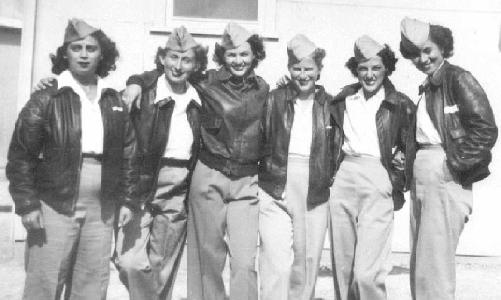
| The Women Airforce Service Pilots of
World War II were pioneers, the first licensed women pilots in the United
States to fly military aircraft for a military service. The WASP was formed
in August 1943 from two earlier, relatively independent programs for women
pilots: the Women's Auxiliary Ferrying Squadron (WAFS) and the Women's
Flying Training Detachment (WFTD).
Before the United States entered World War II, two women had championed the use of women pilots by the military. Nancy Harkness Love, a well-known aviator of the 1930s, advocated a policy of using exceptionally well-qualified professional female pilots for ferrying aircraft, while Jackie Cochran, a world-renowned aviator, had a more ambitious project in mind--procuring and training a relatively large corps of women pilots for a variety of jobs besides ferrying. |

Gertrude Tompkins Silver, WASP, from Summit, New Jersey (1912-44). Missing in service and presumed dead while ferrying a P-51 fighter plane from Los Angeles to the East Coast for shipment to the European theater of operations. A military investigation surmised that the engine of the new aircraft failed shortly after takeoff, and that she crashed in the Pacific Ocean. The patch on her flight jacket showed the unit's official emblem, "Fifinella," a winged woman whom the WASPS said watched over them all. The WASP motto: We live in the wind and our eyes are on the stars. |
|
Former WWII Pilot Betty Jane Williams is being inducted into the Women in Aviation, International, Hall of Fame. Posting date December 2008 |
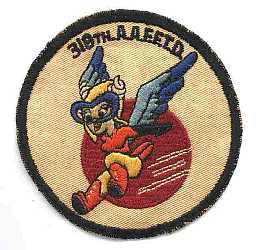
Image copied from here: http://wingsacrossamerica.us/wasp/fifi.htm |
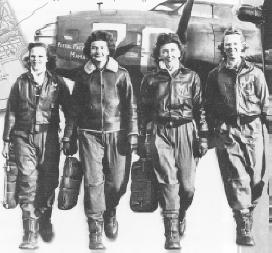
Four WASPS on the flight line at Avenger Field, Sweetwater, Texas. The bomber plane behind them has the nickname "Pistol Packing Mama" painted on the nose. A B-25 bomber similar to the one shown had a top speed of 300 miles per hour, and a pilot had to master six checklists with a total of 76 steps, just to get off the ground. WASPS were sometimes used to demonstrate a new model aircraft, to show nervous male flight crews how safe the plane was. "It was wonderful--and they paid us!" recalled one woman. Another wrote at the time: "As long as the planes fly overhead, the skies of America are free, and that's what all of us are here for. That we are being allowed to help keep that sky free is the most beautiful thing I have ever known!" Go HERE and select GOOGLE Type in: "Avenger Field, Sweetwater, Texas" (Include the double quotes so you get the search-on-phrase) |
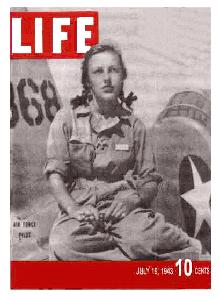
July 19, 1943 LIFE magazine Shirley Slade, one of the U.S. women who earned their wings as pilots while members of the Women Airforce Service Pilots (WASPS), during WWII. Wearing cut-down men's flight uniforms and sometimes sitting on cushions so that they could see out of the plane windows, the WASPS passed the same basic flight-training requirements as male pilots, and learned to fly every aircraft the Army and Navy had, from cargo planes to fighters and bombers. After graduating, they were assigned as engineering test pilots, target-towing pilots for military training missions, and ferry pilots moving aircraft around the country. 38 WASPS died in the line of duty, when their engines failed or their aircraft exploded, or night or snow blinded them, or when planes collided over crowded military airfields, a not-uncommon wartime tragedy when radar and air traffic control were both brand-new concepts. Owing to the fact that the uniformed WASP program was not directly tied to one of the armed services, the dead were buried without military honors, and the surviving WASPS were not legally recognized as "veterans" until 1977.Veterans Bill
From: WASPs: Women Airforce Service Pilots via search.dma.mil
In 1977, Congress acknowledged that WASPs were veterans of WWII. In 1984, each WASP received the Victory Medal, and those serving for more than one year also received the American Theater medal." |
LINKS
A People At War - Women Who Served From the National Archives(NARA) A People At War - Women Who Served From the Military Museum of Texas Wings Across America's FLYGIRLS of WWII Their Bases WASP Resources Women At War From the Atterbury-Bakalar Air Museum at the Columbus Indiana Municipal Airport |
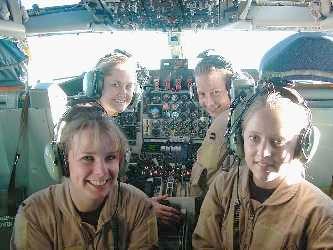
One of the women who served was Captain Lillian Kinkela Keil, a member of the Air Force Nurse Corps and one of the most decorated woman in the U.S. military. Captain Kinkela flew over 200 air evacuation missions during WWII as well as 25 trans- Atlantic crossings. She went back to civilian flying with United Airlines after the war, but when the Korean conflict errupted she donned her uniform once more and flew several hundred more missions as a flight nurse in Korea. Captain Kinkela-Keil was the inspiration for the 1953 movie "Flight Nurse" and served as technical advisor to the film. Her decorations include the European Theater of Operations with Four Battle Stars; The Air Medal with Three Oak Leaf Clusters; The Presidential Unit Citation with One Oak Leaf Cluster; The Korean Service Medal with Seven Battle Stars; The American Campaign Medal; The United Defense Medal; and Presidential Citation, Republic of Korea. Captain Kinkela has been honored several times in her home town of Covina Hills, California and is still quite active in the VFW. Information source HERE |
| Covina woman part of
D.C. WWII Memorial Dedication
By Christina L. Esparza - Whittier Daily News Staff Writer 29 May 2004 - COVINA HILLS Source http://www.whittierdailynews.com On the day before she heads to Washington, D.C., for the first time in decades, Lillian Keil is a bit flustered. She offers visitors coffee, Coke and cookies and points to unpacked clothes around her house and a decorative flower arrangement on the floor that hides a hole. With the honor of being the most decorated woman in U.S. military history, and appearing on television several times, Keil is still nervous at the thought of her latest honor an honorary grand marshal at the National World War II Memorial dedication parade Monday. "I feel a little squeamish," Keil said as she clutched her hands together and grinned. "There's going to be a newspaper reception." About 5,000 people are participating in the first National Parade to Salute World War II Vets, said Michael De Paulo, parade marshal for the World War II Veterans Committee. The parade is coinciding to the official dedication Saturday of the National World War II Memorial on the National Mall in Washington, D.C. "I think it's a really neat parade," De Paulo said. "A lot of history is reflected in it.' Keil, who declines to say how old she is ("You never ask a lady her age"), was a flight nurse for the U.S. Army Air Corps during World War II and the Korean War . In her 14-year tenure with the U.S. Army Air Corps, she flew 425 missions in the wars, and earned four air medals, four Presidential Unit Citations, the World War II Victory Medal, four battle stars in World War II and a Korean Air Service Medal with seven battle stars. She also got a date with silve-screen heartthrob Cary Grant. "It was all horrible, but it was all beautiful,' Keil said of her missions. "I would do it again." She sits at a table and thumbs through stacks of photographs and letters. Behind her sits about a dozen thick, three-ring binders, which she says are full of correspondence related to her service. One note she has was written by a patient on her plane, who had his face all but blown away. It said: "Will I live?" Keil assured him he was going home. She remembers being there on D-Day and at the Battle of the Bulge. Although the plane she rode carried wounded soldiers, it also carried weapons and gasoline, so it could not bear the American Red Cross symbol. It was dangerous, she knew, but she had a very important job to do. "It was sad to see those boys," Keil said. After the Korean War, Keil's work continued, as she became a technical adviser for the 1954 movie, "Flight Nurse," starring Joan Leslie. Keil left the military in 1954, after becoming pregnant with her first daughter. "They didn't have maternity leave back then,' she said. The lives she touched spoke volumes after appearing on Ralph Edwards' show, "This is Your Life.' Her appearance generated tons of mail, mostly from wounded veterans who remember her taking care of them. Her appearance in 1961 received one of the show's 10 highest- mail responses. "These little experiences were just wonderful,' she said. -- Christina L. Esparza can be reached at (626) 962-8811, Ext. 2472, or by e-mail at christina.esparza@sgvn.com . |